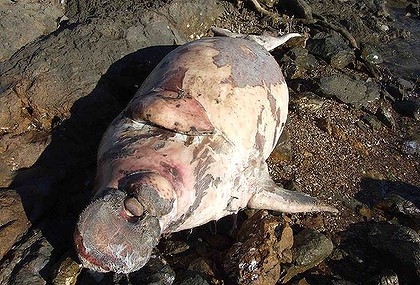
In response to a Right to Information request, the Department of Environment and Resource Management has provided reports for 13 of the dugongs, turtles and dolphins found dead in Gladstone this year.
The documents reveal veterinary scientists from Gladstone Veterinary Clinic and the University of Queensland's Diagnostic Services reported the cause of death was unclear or unknown for 10 of the marine animals.
In the remaining cases, net entrapments and entanglements in fishing line were cited as possible causes of death but no definitive conclusions were drawn.
Statistics provided by the department show 10 dugongs, 231 turtles and six dolphins have died in Gladstone between January 1 and October 18 this year.
Last year, only three dugongs and 38 turtles were found dead in the area.
The water quality and health of fish in Gladstone Harbour has been in sharp focus this year.
A three-week fishing ban was imposed on the central Queensland harbour on September 16, after sick fish with skin lesions and cloudy eyes were found.
Some fishermen had blamed the water in the harbour for causing the problems, suggesting large-scale dredging projects had stirred up contaminants.
Environment Minister Vicky Darling said a review of data had shown little change in water quality during the past year, including since dredging projects began.
But there was some change in water quality after January's floods.
In October, Fisheries Minister Craig Wallace said tests had shown the water was safe for commercial and recreational fishing to resume.
But some fishermen remain concerned about water quality, with up to 20 fishers issuing statements to Queensland Health complaining of painful boils on their arms and legs.
Three multi-billion-dollar LNG projects are currently planned for the Gladstone area, requiring dredging around Curtis Island and a dramatic increase in ship traffic.
The Gladstone Ports Corporation has permission to dredge 46 million cubic metres from within the harbour boundaries, which lie within the World Heritage area, over the next 20 years.
The project has sparked international interest, with the United Nations Environmental, Scientific and Cultural Organisation calling for a comprehensive strategic assessment of the entire Great Barrier Reef World Heritage area.
The request comes amid UNESCO's claims that it was not notified about the dredging within the protected World Heritage area.
Gladstone resident Clive Last has been taking pictures of the dead animals that have washed on the shore since May and is looking for an explanation.
Mr Last was worried that the marine life of Gladstone Harbour is being sacrificed for the expansion of industry in the area.
"The people that are against the LNG industry as a whole are against it because of the position of the plant, not LNG itself," he said.
"It should never have been built on Curtis Island, it is a protected area and a dolphin and dugong sanctuary.
"How can we build all this infrastructure and dredge that much soil out of their feeding grounds when it is meant to be a sanctuary for them?"
James Cook University marine biology and aquacultre expert Dean Jerry said the dredging could be stirring up toxic sediment, which would leave the animals more likely to be affected by disease.
"What happens with dredging is that you stir up sediments on the ocean floor," Associate Professor Jerry wrote in an recent article for The Conversation.
"Once you get down below the first couple of centimetres, that sediment is quite often what we call a deoxygenated environment, where there's a lot of things such as heavy metals and hydrogen sulphide gas.
"As soon as these compounds hit the water column they start to oxidise. This can draw a lot of oxygen out of the water and create a chemical oxygen demand, which means there's less oxygen available for organisms to actually use.
The Gladstone Port Authority, which is responsible for water testing, issued a report last month that showed no link between the dredging and "lesions" found in fish in the harbour.
It found that levels of aluminium, copper and chromium did exceed the safety guidelines at several sites in the harbour.
The Gladstone Port Authority, which is responsible for water testing, issued a report in October that rejected this theory, claiming there had been no water deterioration trend from February to August.



I used to live in the beach town Tannum Sands just a couple of miles down from Gladstone. I was amazed back in the 70's how many ships came threw the harbour back then. You could see them lined up one after the other waiting to get in to Gladstone. I can't imagine how many ships go thru there now ! I guess the population has exploded in the Gladstone area.